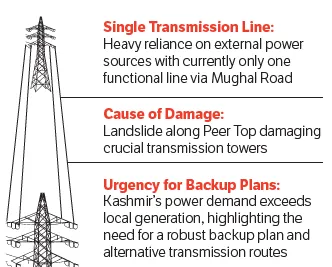Srinagar, Apr 30: Kashmir, which is heavily reliant on external power sources, is currently grappling with a precarious power supply situation.
The Jammu and Kashmir Power Trading Corporation Limited (JKPTCL) has revealed that the Valley’s electricity supply is now dependent on a single transmission line via the Mughal Road.
The dire circumstances arose due to a land sinking that caused significant damage to transmission towers along the Peer Top in the Ramban district.
This area houses crucial transmission lines that typically supply power to Kashmir from the Northern Grid.
In a statement on the microblogging site X, the JKPTCL acknowledged the gravity of the situation, saying, “Please be informed that due to unprecedented rainfall, there has been significant damage to transmission towers along Peer Top. We are currently relying on only one connection to the Northern Grid.”
The corporation emphasised the need for contingency plans, saying, “All essential services must have backup plans in place to address any potential issues arising from this situation, for the public’s well-being.”
While the JKPTCL attempted to allay immediate concerns, it also highlighted the possibility of a complete power outage in Kashmir.
“There’s no need for panic at the moment. However, if our last remaining connectivity is disrupted, which is unlikely but not impossible, the situation could escalate, affecting not just a particular district but the entire valley,” it said.
The development has set the alarm bells ringing among the residents and officials alike, as Kashmir’s power demand heavily outstrips its local generation capacity.
Kashmir relies on external sources to bridge the significant gap between supply and demand, making it vulnerable to disruptions in transmission infrastructure.
Experts have long cautioned about the need for a robust backup plan and alternative transmission routes to ensure uninterrupted power supply to Kashmir.
The current crisis has brought these concerns to the forefront, underscoring the urgency for immediate action.
Kashmir Valley’s connection to the Northern Grid is facilitated through multiple transmission lines, including two 400 kV double-circuit lines, running from the Grid Substation (GSS) Kishanpur in Jammu to New Wanpoh in Kashmir, passing through the Peer Top (Jawahar Tunnel) route.
Additionally, there is a 220 kV double-circuit line operated by the JKPTCL, which also traverses the Peer Top route.
“All three transmission lines passing through the Peer Top route have been taken out of service due to tower collapses or as a precautionary measure. However, the transmission line via the Mughal Road is currently capable of meeting the Valley’s power demand, ensuring an uninterrupted supply,” a senior Power Development Department (PDD) official said.
An alternate 400 kV double-circuit transmission line laid through the Mughal Road from GSS Samba in Jammu to Amargarh in Kashmir has proven to be a lifeline in the wake of the Ramban incident, officials said.
Shedding light on the current power supply scenario, a senior PDD official said that Kashmir was presently importing 300 megawatts (MW) of electricity from the Northern Grid via Mughal Road transmission line, while the remaining supply of 700-900 MW was being procured locally from projects operated by the National Hydroelectric Power Corporation (NHPC) as well as those owned by the Jammu and Kashmir Power Development Corporation (JKPDC).
However, the official underscored the critical need for a robust backup plan to ensure uninterrupted power supply in Kashmir.
“There is a need to have a backup plan,” the official said, outlining two crucial measures that need to be implemented.
The official emphasised the importance of augmenting the region’s power generation capacity.
“One way is to augment our power generation,” the official said, pointing to the numerous power projects in the state sector in Kashmir that have been announced but have yet to witness significant progress.
The official stressed the necessity of establishing alternative transmission lines to ensure redundancy and mitigate the risk of power disruptions caused by damage to existing infrastructure. “We also need to have alternative transmission lines as well,” the official said.







